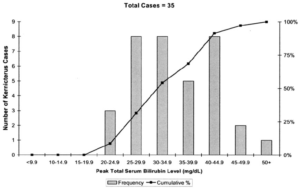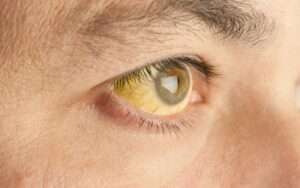Define kernicterus
Kernicterus is a critical health problem. It happens when there’s too much bilirubin – a yellow pigment in our bile – in our blood. This overload can travel to the brain causing harm. Kernicterus occurs in adults but Especially in new-borns, kernicterus can cause substantial problems. Severe jaundice is a common sign of kernicterus. If it’s not treated quickly, it can lead to long-lasting brain issues.
Kernicterus bilirubin level

Kernicterus in babies varies. It depends on their age, general health, and personal risk. But usually, it happens when bilirubin levels go over 20 milligrams per deciliter (mg/dL) in newborns.
Checking bilirubin levels regularly is key. This is particularly true for babies at risk for jaundice or kernicterus. It’s vital to get medical help if levels exceed safe limits.
kernicterus pronunciation
Kernicterus is pronounced as “ker-nick-ter-us.”
Kernicterus in adults
Kernicterus rarely affects adults. Sure, adults might get high bilirubin, yet kernicterus hardly happens. Following are the reasons:
- Mature Livers: Unlike newborns, adults have fully developed and functional livers. This means Adults have stronger livers, they clear bilirubin from the blood faster. It stops bilirubin from getting to unsafe levels.
- Blood-Brain Barrier: The blood-brain barrier, which protects the brain from harmful substances, is generally stronger in adults compared to newborns. This makes it more difficult for unconjugated bilirubin to enter the brain tissue.
Some adults may be more prone to kernicterus under certain conditions:
- Certain Inherited Conditions: Rare genetic disorders like Crigler-Najjar syndrome can impair the liver’s ability to process bilirubin, leading to potentially high levels even in adults.
- Severe Liver Disease: Conditions like advanced cirrhosis or fulminant hepatic failure can severely damage the liver, hindering its ability to eliminate bilirubin effectively.
- Certain Medications: Some medications can interfere with the liver’s normal function and contribute to elevated bilirubin levels, though the risk of kernicterus remains very low.
Kernicterus symptoms in adults

Kernicterus in adults can show up in different ways. These signs point to problems brought on by too much bilirubin. Let’s look at some common signs:
- Jaundice: If you have kernicterus, jaundice can happen. You’ll notice yellow skin and eyes. This is caused by high bilirubin.
- Tiredness: For adults with kernicterus, they often feel ongoing fatigue. It can disrupt their everyday tasks and happiness level.
- Stomach Ache: Kernicterus patients sometimes suffer from stomach pain. The severity of this discomfort can vary.
- Feeling Sick and Throwing Up: For those with kernicterus, being nauseous and vomiting can happen, particularly when bilirubin levels rise quite high.
- Being Confused: Kernicterus can impact thinking skills which may result in confusion or even a hard time focusing among adults.
- Muscle Stiffness or Rigidity: Kernicterus makes muscles stiff. It’s especially true for arms, legs, and neck.
- Neurological Symptoms: If kernicterus gets worse in adults, they might shake uncontrollably. Some might have seizures. Others will struggle to keep their balance.
What medicine reduces bilirubin quickly in adults?

For grown-ups, there’s no swift cure to lower bilirubin. But specific drugs can handle conditions that raise bilirubin. They assist your liver or deal with issues like liver disease or hemolytic disorders. Here is a list of usual treatments for high bilirubin in adults:
Ursodeoxycholic Acid (UDCA):
UDCA is often used to cure some liver problems, primarily cholestatic liver diseases. It works by boosting bile flow and lessening bilirubin pile-up in the blood.
Phenobarbital:
Phenobarbital, another medicine, works differently. It triggers liver enzyme operations which arguably boosts the bilirubin breakdown. This results in lowered bilirubin levels in the blood.
Cholestyramine:
Cholestyramine is a type of bile acid sequestrant. Its job? To reduce bilirubin levels. It does this by sticking to bile acids in your gut, which stops them from being reabsorbed. The result? More bilirubin leaves your body.
Steroids:
But what about certain cases of high bilirubin, like those involving autoimmune or inflammatory issues in the liver? That’s where steroids may come in. They can help calm the inflammation, making your liver work better.
How do you treat hyperbilirubinemia in adults?
There are methods to deal with it, though these are just common examples:
- Addressing the underlying condition: Depending on the cause, this could involve medications, dietary changes, surgery, or other interventions specific to the underlying disease.
- Supporting the liver: Certain medications might be used to help the liver function more efficiently and remove bilirubin from the bloodstream.
- Phototherapy: Phototherapy is usually for newborns. But sometimes, adults with very high bilirubin levels also need it. One way is to use specific light wavelengths on the skin. This policy makes bilirubin break down easier for the body.
- Plasmapheresis: This is a specialized procedure where a portion of the blood plasma containing bilirubin is removed and replaced with a new solution. Usually, we only think about this when other treatments don’t work. But these are extreme situations.
Is kernicterus reversible?
Kernicterus, sadly, can’t be cured. The brain harm from high bilirubin is here to stay. Yet, find and treat high bilirubin early? This can cut the risk of kernicterus right at the start.
What medicine reduces bilirubin quickly in adults?
No single drug quickly lowers bilirubin in adults. Rather than directly reducing bilirubin, hyperbilirubinemia treatment targets the root problem, aiding liver function. Always see a health expert to properly assess and handle high bilirubin in adults.
Can high bilirubin cause brain damage in adults?
Indeed, adults could get brain damage from high bilirubin levels, but this is rarer than in newborns. Hyperbilirubinemia refers to the dangerous spike in bilirubin. When this occurs, bilirubin can sneak into the brain through the blood-brain barrier. This sneaky move leads to kernicterus, causing troubled brain functions.
What is a dangerously high bilirubin level in adults?
For grown-ups, if bilirubin levels go over 2 to 2.5 milligrams for each deciliter (mg/dL), it’s high. It could mean hyperbilirubinemia. Yet, what’s seen as dangerously high can change. Things like health issues and how much the person can tolerate play a part.
Can adults recover from high bilirubin?
Yes, it’s possible for adults to get better from high bilirubin levels. This often involves the right medical help and care. Treatment usually targets the root problem causing excessive bilirubin, like liver issues or blood disorders. It could include taking medicine, changing lifestyle habits, and getting extra care. With swift action and the right handling, many adults can fully bounce back from high bilirubin levels and avoid lasting problems.

Pingback: Neonatal Kernicterus (Bilirubin Toxicity)